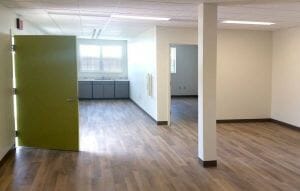On Location with Modular Construction
The Hawaii Film Studio is a film studio known for its work on TV shows and movies such as Hawaii Five-0 and Jurassic Park. Initially, the proposed 7,000 sf office project went over budget using conventional construction, leading the Hawaii Film Studio consider modular construction. Additionally, due to tight time constraints, the general contractor, G70, informed the client that in-factory construction was the only way to meet the project’s compressed timeline. The technical innovation of having the building constructed at the same time as the site was being developed was paramount to saving time and providing the facility before the start of filming the new season of Hawaii Five-0.
After looking into modular, the studio realized that WillScot’s modular solution provided them with the functional facility they needed while leaving enough room in their budget to cover costs for contamination control, construction waste removal, fluid leakage from trucks and equipment rentals. Additionally, choosing modular ensured there would be minimal onsite clean up as most waste materials and hazardous fluids would be handled at the factory some 2,500 miles away at the Blazer Industries facility in Oregon.
The designers worked with the factory to address all of the technical needs of the film studio’s specialized departments, including wardrobe, props, art, production, and graphics. The building was completed at the plant to save time and comply with noise requirements at the site. The building was also designed to allow future expansion, providing the ability to move buildings around and create new configurations as needs changed.
The building is located near the entrance to the historic Diamond Head State Monument. As such, the state required the office to blend with the surrounding landscape. The building was finished with earthy colors that matched the volcanic terrain.
Inside, the facility was customized with PTAC cool/heating systems to maintain humidity control and prevent damage to the film crew’s wardrobe, prop production and storage. It was also outfitted with custom electrical components and lighting to support the film crew’s computer and design needs.
In all, the project was completed in 275 days and in time for filming the new season of Hawaii Five-0!
This article originally appeared in the Modular Advantage Magazine - Second Quarter 2019 released in May 2019.
More from Modular Advantage
Resia: Breaking All the Rules
Resia Manufacturing, a division of U.S.-based Resia, is now offering prefabricated bathroom and kitchen components to industry partners. Its hybrid fabrication facility produces more precise bathroom and kitchen components (modules) faster and at lower cost than traditional construction. Here’s how Resia Manufacturing does it.
How LINQ Modular Innovates to Bring Modular To The Market in the UAE and Beyond
LINQ Modular, with an office and three manufacturing facilities in Dubai, is a modular firm based in United Arab Emirates. The company is on a mission: to break open the housing and construction markets in the Gulf Cooperation Council (GCC) area with modular.
ModMax: Redefining Modular Construction with Confidence and Precision
ModMax was born out of frustration—frustration with five persistent pain points in modular construction: Permitting bottlenecks. Production delays. Rigid designs. Disconnect between “the office” and the field. Lack of transparency and communication.
LifeArk: Disaster-Resilient Housing from Recycled Plastic and 100-year-old Technology
Wee compares LifeArk’s housing units to Yeti coolers, as they are built similarly. Each component takes 15 to 20 minutes to manufacture, has an R-value of 40, and includes molded slots and chases for wiring, plumbing, fire sprinklers, and other utilities.
Building the Future of Modular Edge Infrastructure
The edge data center market is expanding rapidly, driven by the surge in AI workloads, IoT adoption, and the need for localized compute power. In these environments, sustainability, scalability, and reliability are non-negotiable. Cooling is among the most complex challenges for operators—and one of the most decisive factors in long-term success.
Accelerating Light-Gauge Steel Construction: A Semi-Automated Digital Workflow for Off-Site Projects
For construction professionals, the message is clear. By adopting semi-automation and digitalization, companies can deliver projects faster, more accurately, and more profitably, while also building stronger collaboration across teams. The approach is not about replacing people with machines, but about empowering people with better tools and processes.
Why Modular Data Centers Are Gaining Momentum
Artificial intelligence, high-performance computing, and edge applications push the limits of traditional “stick-built” data centers. They take years build, often struggle with high density workloads, and aren’t optimized for deployments near end users. Modular data center platforms are purpose-built to address these challenges, offering flexibility and scalability to adapt to evolving technologies, while opening new opportunities for the modular construction industry.
Supply Chain Innovation in Action: 5 Habits Every Modular Leader Should Practice
By applying these principles to supply chain practices — collaborative planning, strategic procurement, scenario modeling, digital tools, and transparent forecasting — construction leaders can build value chains that are not just efficient and agile, but truly innovative.
Exploring the Role of Modular Integrated Construction (MiC) in Advancing Circular City Principles – A Survey of Stakeholder Perspectives
The survey findings highlight the significant potential of Modular integrated Construction (MiC) in advancing the development of circular cities. By reducing costs, accelerating construction timelines, and minimizing waste generation, MiC offers a promising approach to sustainable urban development.
The Use of MS POLYMER™-Based Sealants and Adhesives in Modular Building
These products combine flexibility and elastic recovery with excellent adhesion to different substrates and have already shown their usefulness in traditional construction. Now it’s time for them to be put to use in the modular construction industry.










